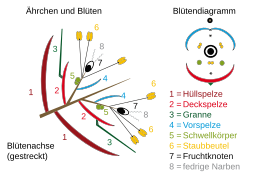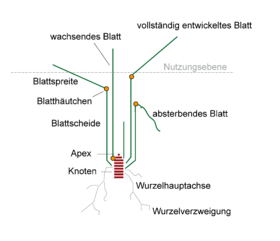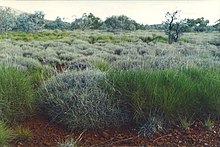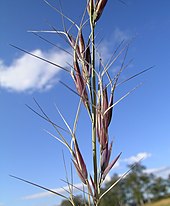Sweet grasses
| Sweet grasses | ||||||||||||
|---|---|---|---|---|---|---|---|---|---|---|---|---|
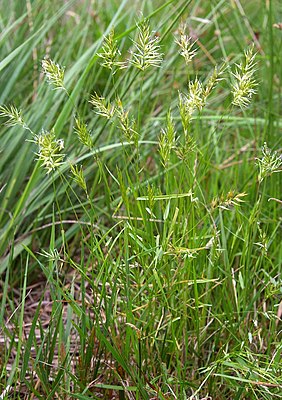
Awn stork ( Anthoxanthum aristatum ) |
||||||||||||
| Systematics | ||||||||||||
|
||||||||||||
| Scientific name | ||||||||||||
| Poaceae | ||||||||||||
| ( R.Br. ) Barnhart |
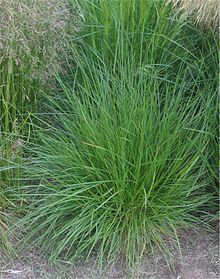
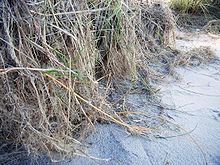
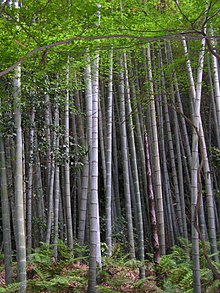
The sweet grasses (Poaceae = Gramineae) are a plant family in the order of the grassy (Poales). With around 12,000 species in around 780 genera, they are one of the largest families within flowering plants . They are distributed worldwide in all climate zones and are characterized by a typical grass-like shape.
Many types of grasses are among the oldest useful plants and have been of vital importance to humans since ancient times. All grains such as wheat , rye , barley , oats , millet , maize and rice belong to this group of plants. In the form of market crops or as fodder in processing, they represent the basis for feeding the world population today. As grass or grassland such as meadows and pastures , but also steppes and savannas , they shape the landscape in large parts of the world.
Life cycle and morphology
Sweetgrasses include both short-lived and long-lived species. They show a characteristic morphology of both the vegetative and the generative organs, with a common "grass-shaped" basic structure of the different species. Grasses are usually slender and have long, thin stalks structured by knots, parallel-veined, long leaves and often inconspicuous, simple inflorescences. Within the subfamilies, tribes and genera, however, there are clear taxon-specific modifications of the characteristics.
Life forms and perseverance
Many species are annual and complete their entire life cycle in one growing season. They usually only live a few months and survive the unfavorable season as seeds in the soil. These forms, which also include many types of grain, are called therophytes .
Other species are perennial and therefore hemicryptophytes . They have renewal buds close to the ground and survive unfavorable times protected by the ground, leaf litter or snow. These include biennial species that germinate in the course of summer or autumn and do not produce fruit and seeds until the following year, as well as perennial and perennial species that live a few or many years. These have clumps or rosettes that can be overwintered. The individuals of a generation of perennial species can live up to 400 years, for example the red fescue ( Festuca rubra ). The common couch grass ( Elymus repens ) is an example of the fact that grasses can renew themselves from stolon fragments ( rhizome - geophytes ). Most of the Hemikryptophyt-kinds are herbaceous ; whose stalks die off above ground after about a year of life. Exceptions are woody bamboo species (Bambuseae), whose shoots are thick-walled and firm and can last for several decades.
Growth forms and roots
Many sweet grasses are delicately built and only a few centimeters tall (e.g. annual bluegrass ). Other species have lignified stalks and reach heights of up to 40 meters and more, such as the bamboo species Dendrocalamus giganteus . Annual and biennial species usually have single or few shoots in loose clusters with softer leaves. In these sweet grasses, all or most of the shoot axes carry inflorescences. In most cases, the perennial species form firmer stalks and leaf blades and, in addition to flowering shoots, a larger or smaller number of non-flowering shoots. They grow in loose or dense clumps or in a grass form. The latter growth form results from the fact that the plants spread either over more or less long, above-ground, greenish or reddish shoot axes, namely stolons (e.g. the white ostrich grass ) or over underground, white or brown rhizomes (e.g. the Common couch grass). In addition to the color, the two types of runners rooting at the nodes can also be distinguished by the fact that stolons have complete leaves with a leaf sheath and leaf blade at each node , whereas rhizomes only develop small, thin, scale-shaped lower leaves at these points . In clump-forming species, only short runners form, or the young side shoots develop within the leaf sheaths of the mother shoot (intravaginally), as in sheep fescue ( Festuca ovina ). In this way, the crowded, standing shoots create the typical tufted, densely clumpy growth form of many grasses. If the shoots grow through the lower leaf sheath (extravaginally), the growth is mostly loosely clumpy or grass-shaped (e.g. red fescue). Most grasses are shallow-rooted ; they do not form main and tap roots. At the base of the stem and at the nodes of the runners, numerous shoot-borne roots are formed, which in turn can develop 1st and 2nd order lateral roots. In this way, root systems of considerable length can arise. A single plant of the red fescue can spread about 250 meters in diameter.
Stalks and leaves
The stalks of the sweet grasses are called Halme ( derived from Old High German Halm from Germanic halma , "straw, grain stalk , grass stalk "). They are mostly hollow and round. Only a few types of grass have pithy stems. They are divided by solid nodes (nodes) filled with tissue. The sections between the nodes are called internodes . The growth zones are located directly above the nodes, so the stalks grow with embedded meristems . At these points, the fibrous reinforcement elements, which give the stalks additional stability and tensile strength, are exposed. In this way, the stalks remain flexible and flexible. This enables you to straighten up again after exposure to wind and rain. They can either grow up vertically, rise from a curved base, or grow completely prostrate on the ground. Blades of grass vary in size, firmness, and the number of nodes. They are mostly cylindrical in cross-section, rarely compressed a little like the compressed bluegrass ( Poa compressa ). In some types of sweet grass, the lowest internodes are more or less swollen and thickened. The stalks of many grasses are unbranched, in some species side branches form from the buds in the leaf axils. The foliage of the stalks is always alternate in sweet grasses and almost without exception two-line (distich) - in contrast to the three-line foliage of the sour grass (Cyperaceae).
The leaves of the sweet grass always consist of two different sections: the leaf sheath and the leaf blade. The leaf sheath corresponds to the leaf base , starts at the node and encloses the internode almost to the next stalk node. The sheaths are open on one side in the majority of grasses. In a few types of grass, the edges are fused and thus the leaf sheaths are tubular, although they tear open early in the upper area. While the basal leaf sheaths protect the growth points of the young shoots, those on the stalks fulfill this protective function for the growth zones there above the nodes and also provide additional stability. The upper part of the leaf sheaths can be bulbous. The front of the leaf sheath end can be pulled out into more or less pointed, mostly stem-encompassing "ears" or can carry tufts of hair. The leaf sheath merges at the upper end into the leaf blade protruding from the stalk. This is flat, rolled or folded; always elongated and more or less pointed. It shows the characteristic parallel veining of monocot plants. Each leaf vein corresponds to a vascular bundle , which is used to transport matter and stiffen the leaf surface.
At the sudden transition from the leaf sheath to the leaf blade, in most species there is a membranous appendage, the ligule . It usually appears as a colorless, translucent projection of the upper skin on the inside of the leaf sheath and is an extension of the inner epidermis is the leaf sheath. It protects against injuries caused by friction of himself when wind reciprocating Halmgliedes and prevent the penetration of dirt and parasites in the space between the stalk and the sheath. Because of its design variety, the ligule is helpful for species identification. It is hairy or hairless, collar-shaped, pointed, elongated, very short or very long. The ligule is partially replaced by a series of hairs, and it is seldom completely absent.
Inflorescences and flowers


The inflorescences (inflorescences) of the sweet grasses consist of a multitude of partial inflorescences, less often single flowers, which are arranged in ears , panicles and grapes on an inflorescence axis (Rhachis spicae). The partial inflorescences are called spikelets . They in turn consist of one or more, predominantly bisexual flowers. If the spikelets sit directly on the inflorescence axis without stalk, it is an ear. In finger grasses there are several ears at the end of the stalk in a finger-like arrangement. So-called cobs are created by modifying ears by enlarging the axis tissue. In clusters the spikelets are on unbranched stems. The spikelets can all point in the same direction (one-sided) or they can be in two rows on opposite sides of the axis. If the side branches are branched on one side or on all sides, they are panicles. In panicles or false ears , the side branches are so short that the inflorescences appear externally like ears. The actual branching pattern only becomes recognizable when such a panicle is bent.
Sweet grasses are characterized by a characteristic reduction in flowers . The spikelets are at the bottom of an inner and an outer glume (Gluma), which can be fused together, edged. Above it are one or more flowers, each with a cover and palea . The lemmas can be regarded as bracts of the single flowers. The husks vary greatly in shape and size. The two glumes can be identical or different. The lemmas are multi-shaped. They can be pointed, blunt or serrated in various ways at the ends. On the back, they are rounded, squeezed or keeled. The midrib can be elongated into a spike or awn .
The flowers consist of a palea and two, rarely three, sometimes fused cavernous bodies (lodiculae), which swell to open the husks. There are also usually three stamens (Stamina) available (often six, two, or only one), each having a stem (filament) and the pollen -bearing, two-part dust bag (anther) has. In each bloom there are finally a round, overgrown of two or three carpels, Upper permanent ovary (ovary). This has a stamp (pistillum) at its tip , which in turn bears one, two or rarely three feathery scar branches (stigmae) on short stems . The ovary contains the ovule, which grows together with the ovary walls to form a unit, the caryopsis .
In some species, some flowers contain only male organs or are sterile. Furthermore, several species are of different ages, that is, the flowers with only female and only male organs are located separately in different inflorescences of the same individual ( monoecious ), as in maize . In other species such as pampas grass , the sexes are located separately in the inflorescences of different individuals of a grass species. They are dioecious .
Fruits and seeds
In most types of grass, the fruit is a dry caryopsis, a special form of the nut fruit . The fruits are more rarely berries or stone fruits with juicy or fleshy fruit walls, as is the case with some types of bamboo. During the ripening period, the pericarp grows together with the seed coat (testa) to form a single, dry closing fruit . The “seeds” do not represent seeds, but rather fruits. Below the pericarp and the seed coat lies the protein-rich aleurone layer . This is followed by the starch- rich nutrient tissue, the endosperm , which fills the remaining seeds . Grasses are monocotyledonous; with them the one germ layer ( cotyledon ) is transformed into a scutellum (shield) and a germinal sheath ( coleoptile ). The scutellum lies between the endosperm and the embryo and plays an important role in the transport of substances and hormone synthesis . The embryo already has clearly recognizable roots and shoots. The coleoptile is a cylindrical protective organ that surrounds the primary leaf of the germinating embryo. Since the coleoptile is a transformed cotyledon, it is a leaf as an organ. Like all leaves it has two epidermis (outside and inside), stomata and vascular bundles . The starch and proteins help the embryo start germination before it can take care of itself through photosynthesis . The ripe fruits of the grass are characteristic in their shape and structure. The former abdominal seam of the ovary appears as a deep furrow on one flank of the grain.
Zones of a special tissue are formed at various points on the fruit cluster, along which a smooth break is created as soon as the seed is ripe. In most grasses, this break occurs in the spikelet axis below the lemma. In these cases, the caryopsis is usually firmly enclosed in lemmas and palea and as a whole represents the dispersal unit ( diaspore ). In some species, the break occurs below the lowest lemma of the spikelet (e.g. pearl grass ), below the individual spikelet or in a clump of spikelets (barley), rarely in the main axis of the fruit cluster ( thin tail ). Bare fruit grasses are common in the tropical genera Sporobolus and Eragrostis . In these, the grain stands free and is scattered after a break has developed at the base of the lemma holding it.
Chemical characteristics
The seeds are rich in starch . This can consist of individual starch grains (rye, wheat, barley) or multiple starch grains (oats). The grasses also store starch, sucrose and / or fructans in the rhizomes and other vegetative organs . In addition to the unbranched “inulin type”, the branched “phlein type” occurs among fructans. The fructan pattern, like the degree of polymerisation, is often characteristic of the species. The outer endosperm layer (aleuron layer) of the caryopses is rich in reserve proteins. It mainly contains albumins , globulins , glutelins (only soluble in dilute acids and bases) and prolamines ( soluble in 70–80% ethanol). With rye or wheat flour, the latter are a prerequisite for baking ability .
Some panicoid tribes produce essential oils in tubular, corked cells. Cymbopogon nardus supplies the aetheroleum Citronella, which consists mainly of citronellal and geraniol and often replaces the real lemon balm oil in the production of lemon balm spirit. More species of Cymbopogon are grown as they provide perfume oils such as palmarosa oil and lemongrass oil . These oils consist predominantly of mono- and sesqui terpenes , while phenylpropanoids are rare. Alkaloids are rare. There are protoalkaloids and a few pyrrolizidine and β-carboline-type alkaloids. Cyanogenic glycosides (compounds that produce bluish acid) are widespread, but only ever occur in small quantities. Coumarins are probably found in all representatives, but only in larger quantities in common stalk grass ( Anthoxanthum odoratum ) and in scented Mariengrass ( Hierochloe odorata ). Polyphenols are contained in smaller quantities.
As with the sour grasses (Cyperaceae), silica is often stored in the leaf epidermis in the form of silica bodies. Oxalate crystals seem to be completely absent.
As bitter substances, many of these ingredients have an anti-feeding effect or have a toxic effect on bacteria or fungi.
ecology

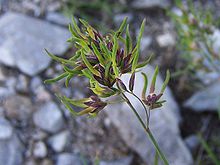
Vegetative growth, expansion and regeneration
In perennial species, vegetative spread occurs mainly via stolons and rhizomes that take root at the nodes. A number of species also make use of the false viviparity, in which no seeds are formed, but rather brood buds (bulbils) that produce inherited daughter plants. A well-known example is the Alpine bluegrass ( Poa alpina ). In this grass, instead of flowers, green plants develop in the inflorescence that remain on the mother plant or fall to the ground and serve as diaspores. When onion bluegrass ( Poa bulbosa ) is basal, onion-like leaf buds, in which form reserve materials are incorporated. Each brood bud forms the basis for a new plant.
Grasses are capable of rapid regeneration after browsing or mowing . This is due to the protected position of their leaf growth zones ( meristems ) and secondary shoots buds. The growth zones are located at the base of the grass plants near the surface of the earth. The shoots consist of leaves of different ages and oppositely arranged. Young leaves grow at the base of the leaf sheath (intercalary meristem). This enables the leaves to grow again after they have been lost through mowing or grazing. The individual leaves, like the stalks at the upper end of the leaf sheaths in the transition to the leaf blades, also have divisible tissue that can form secondary shoots. Furthermore, due to the different growth of the divisible zones above the nodes, the stalks are able to erect the stalk again after rain or step.
The growth areas described are divided into different zones: At the base, cells divide and thus cell production takes place. This is followed by an area of cell stretching. In the following zone of cell differentiation , the leaf cells develop. Cell production and cell elongation move the differentiated leaf upwards. As soon as the leaf emerges from the leaf sheath, it is photosynthetically active.
Generative propagation and spread
All sweet grasses are wind- blooming (anemogamous). The flowers only open a few hours a day to expose stamens and stigmas to the wind. A self-pollination is the most mature sooner the stamens prevented ( Proterandrie ). The large reduction in the number of flowers is an adaptation to this form of pollination . Grasses can do without conspicuous shapes and colors of the flowers and without a supply of nectar to attract animals. The passive transfer of pollen via the wind and air currents is far less targeted than with animal pollination. The wind bloomers compensate for this deficiency with the mass production of pollen. This leads to real clouds of dust during the flowering period, which guarantee that at least a small part of the pollen that is less than a day viable reaches its destination, the female stigma. For example, rye ( Secale cereale ) produces around four million pollen grains per ear; a single flower up to 57,000. A large flower cover would only be a hindrance to the spread of pollen. The lodiculae swell when water is absorbed and force the husks apart - the "grass flower" opens. The filaments are long and thin and let the dust bag free from the flower hanging out. In this way the wind can carry out the dry, non-sticky and light pollen unhindered. The ovaries have pinnate scars with a large surface area, which can sort of comb the pollen out of the air. The efficiency of this form of pollen distribution is increased by lifting the inflorescences above the level of the foliage and by the high density of grass plants. A special form of sexual spread is true viviparity , in which the seeds germinate on the mother plant. The seed dispersal is done in many ways; mainly by the wind ( anemochory ), over the water ( hydrochory ) or by animals ( zoochory ).
Mycorrhiza
The root system of the meadow grass forms arbuscular mycorrhiza (AM), a symbiosis with a fungus . This makes it easier for the grass plant to develop and absorb nutrients from the soil. A mycelium of fungi connects several plants of the same species and other plant species, whereby not only the grass itself and the fungus, but ultimately the meadow and the fungus form a community.
photosynthesis
Among the grasses there are both C3 (most domestic grasses such as German ryegrass ) and C4 plants (e.g. maize , millet and sugar cane ), the latter with more efficient photosynthesis with a high supply of heat and light. C3 plants, on the other hand, show more efficient photosynthesis at cooler temperatures and less light. Research has shown that the C4 mechanism was first developed in the Gramineae, probably in the Oligocene around 23 to 34 million years ago, with evidence of over ten independent developments. The geographic distribution shows a noticeable climatic dependence of the photosynthesis types . The proportion of C4 plants among the grasses in cool and humid climates is significantly lower than in dry to extremely arid regions of the world.
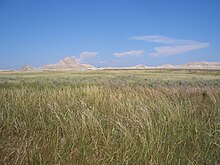

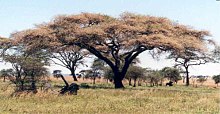
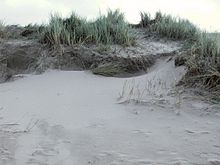
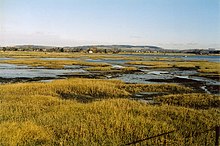

Synecology, biotopes and importance
Natural and anthropogenic grasslands
About a fifth of the world's plant cover is made up of grasses. Savannas and steppes form the earth's large, natural grasslands in climates that are unsuitable for forests. On the other hand, there are the cultivated grasslands created by human activity, especially in Central Europe, which emerged in a long post-glacial process from the forest to the open landscape characterized by meadows and pastures.
The permanent, more or less closed grass stands fulfill a variety of ecological and biological tasks. Above all, thanks to their dense and closely networked root system, they prevent the soil layer from being eroded by wind and water ( erosion ). Furthermore, through their roots, they generate a high level of organic matter in the soil . Around two thirds of the primary plant production remains underground in grasslands and thus leads to humus formation . The annually dying aboveground plant material also contributes to this, which remains as mulch and is only slowly decomposed. Natural fires play a role in many grasslands. At the end of the growing season, lightning ignites the dead plant matter. The inorganic nutrients contained in the ash act as fertilizer to encourage the plants to sprout again. In addition, the woody growth is destroyed, so the fires help to keep the grassy landscape open. Grasslands are home to and feed a diverse animal world: a multitude of insects ( termites and ants ), spiders , birds , small mammals and numerous animals living in the ground, not least large mammals such as those of the large herds of animals in the African savannas. The latter, like the regular fires, help to inhibit the rejuvenation of the trees. Their excrement fertilizes the soil. By eating, the regeneration of the grass is stimulated in such a way that primary production increases by more than two thirds. Furthermore, they are important for the spread of fruits and seeds through epi- , endo- or dysochoria . Near-natural grasslands are declining worldwide today. The causes lie in the conversion into arable and settlement land, the abandonment of traditional meadow or pasture uses as well as in intensification (fertilization) and degradation ( overgrazing ).
Steppes and prairies
The tree-free steppes are found in the semi-arid, temperate zones mainly in the northern hemisphere. In the southern hemisphere, the Argentine pampas are analogous to the Eurasian steppes and the North American prairies. There is some controversy about whether it was created naturally. Steppes are subject to two periods of dormancy in the course of the year due to the severe cold in winter and persistent drought in summer. The rainfall that occurs in spring, early summer and late autumn is sufficient for the steppe vegetation to grow. The steppes are characterized by their high biological activity and a high proportion of humus (up to 10%). Fertile black earth soils with humus horizons of up to one meter in thickness can form. The Eastern European steppes can be roughly divided into about four types of vegetation, which follow the increasing continentality towards the southeast. In Russia and the Ukraine to find meadow steppes with upright brome ( Bromus erectus ), fluffy meadow oats ( Avenula pubescens ), Schiller grasses ( Koeleria ) and many other grass species. They are rich in one year, and not grassy perennial herbaceous plants . This is followed by Pfriemengräser the genus Stipa dominated spring grassland with narrow-leaved "Horst grasses" and less perennials , and finally the short grassland with xerophytic Festuca species. Western outposts of the Eastern European steppes can be found, for example, in the Pannonian Plain of Hungary. In temperate North America , the steppes correspond to the much smaller prairie between Mississippi and the Rocky Mountains . In contrast to the Eastern European steppes, it is less continentally shaped. It reaches 1000 kilometers from west to east and 2750 kilometers from north to south. In the east, the tall grass prairie with is Kentucky bluegrass ( Poa pratensis ), the pyramids Schiller grass ( Koeleria pyramidata ), Prairie Bluestem ( Andropogon scoparius ), switchgrass ( Panicum virgatum ) and many herbaceous plants. In the south, the mixed grass prairie follows in the transition to the short grass prairie at the foot of the Rocky Mountains with mosquito grass ( Bouteloua gracilis ) and Buchloe dactyloides . The importance of closed grass coverings as protection against erosion is shown by the devastating sandstorms of the 1930s in North America's so-called “ Dust Bowl ” due to large-scale soil destruction in the course of the conversion to arable land. In the 17th and 18th centuries, herds of buffalo with an estimated population of 50 to 70 million animals roamed the prairies. Today there are over 100 million domestic cattle.
Savannahs
The savannas cover about 15 million square kilometers. In the humid summer rain areas of the tropics of the southern hemisphere, they reach their greatest extent in Africa . Similar formations of the savannas are the Llanos of Venezuela and Colombia , the Cerrados of Brazil and the eucalyptus steppes of northern Australia . In contrast to the steppes and prairies, savannas are interspersed with trees and shrubs. Without fire and the influence of the large herds of elephants and ungulates, the savannahs of Africa would quickly become overgrown with trees. In the savannas there is often a small-scale surface relief of flat hills and depressions with height differences of less than one meter. As a result, the locations differ primarily in terms of water availability. The different water availability ultimately determines the nutrient availability and vegetation. In savannahs, termites, ants and grasshoppers play a key role as regulators in the ecosystem , alongside large animals . The species richness of the plants of the savannah is comparatively low. The main components are C 4 grasses such as the lamp cleaner grass ( Pennisetum ) and Andropogon species in Africa. In Australia, the savannahs, the so-called spinifex or hummock grasslands , are characterized by hedgehog head grasses of the genera Triodia and Plectrachne . In contrast, the species diversity of the animals is extremely large. Around 1.5 million large animals live in the savannahs of the world, in the Serengeti of East Africa alone there are 98 large grazing animals per square kilometer. The zoomasse is estimated at 150 to 250 kilograms of dry matter per hectare - that of the forests of the temperate zone is given as only 10 kilograms of dry matter per hectare.
Cultivated grassland
In the natural landscape of Europe, natural grassland is limited to a few areas. Only in high mountain areas above the tree line , in sea marshes , often in flooded Auenbereichen and the edges of bogs to small-scale natural, largely treeless grasslands were called Ocean Acidification , develop. Today they are heavily influenced by people. Cultivated grassland serves the people economically as a basis for animal husbandry. The meadow and pasture landscapes of temperate Europe, dominated by grass, are essentially the result of centuries of human activity. Around 10,000 years ago, Central Europe was almost entirely forested. The development of peasant cultures, which spread from the Middle East to Central Europe about 6700 to 6400 years ago ( Neolithic ), made it possible for people to settle down and led to ever greater interventions in the natural plant cover. There were settlements, the first fields and farm animals that looked for their first food in the forest. The feeding of the animals, fire and logging led to clearings in the woods over a long period of time. With the beginning of the Iron Age , land use was increased, and with the invention of the scythe the extraction of hay and litter became possible. In this way, the first larger meadow areas were created. In the Middle Ages, the development of the landscape was completed in an open and differentiated cultural landscape made up of settlements, forest remains, field trees, bushes, fields and species-rich meadows and pastures. The typical landscape is often described in the literature as “parkland” or “European savannah”. In the course of agricultural development in modern times, agriculture is becoming more and more independent of natural conditions through technology, land consolidation , amelioration and the targeted sowing of selected types of grass. The species-rich, extensive meadows and pastures were largely replaced by species-poor, monotonous farm meadows and pastures. The most important forage grasses cultivated in permanent grassland today include German ryegrass ( Lolium perenne ), meadow timothy ( Phleum pratense ), common ball grass ( Dactylis glomerata ) and meadow and reed fescue ( Festuca pratensis , Festuca arundinacea ).
Coastal and flood protection
With their thin network of roots and the covering of the ground with their aboveground plant parts, a number of grasses not only prevent it from being carried away by wind and water, but also ensure that it is elevated. Species that can form long-range rhizomes and stolons under relatively unfavorable site conditions are particularly suitable for this. The common beach grass ( Ammophila arenaria ) , for example, plays a key role in defining the quicksands and in building up the white dunes on the islands and on the mainland coasts, thus fulfilling an important function in coastal protection. On the regularly flooded mud flats of the coast, it is the beach salt swaths ( Puccinellia maritima ), which gradually form the short, dense lawns of the salt marshes with its stolons that take root and which, with its short stiff stalks and leaves, to a certain extent trap the mud and slowly increase the surface of the marsh . Where other sweet grasses can no longer thrive, the salt silt grass ( Spartina anglica ) takes on the function of defining and raising silt on the seaward sides in the Wadden Sea and along the tides at similar locations . The dykes of the coasts and streams are finally equipped with a plant cover, which is dominated by soil-retaining sweet grasses.
In the plains along the inland river banks, grasses protect the soil from erosion and play an equally important role in flood protection. For example, the cane grass ( Phalaris arundinacea ) and the water swaths ( Glyceria maxima ) form dense and tall growths with strong rhizomes on muddy surfaces and on banks. River floodplains not only represent retention areas for floods, but are also a sink (“trap”) for sediments, nutrients and pollutants due to the large grasses.
Use and importance for humans
The grass family offers a wide range of uses. In contrast, however, there are only relatively few genera that are ultimately important as useful plants for humans. Only 6 to 7 percent of the 600 to 700 species are used as food or as building materials. Only about 15 genera, that is just under 2 percent (without taking the bamboo genera into account), play a larger role.
Grain
Grains are of great global economic importance. Grass fruits, or cereal grains, serve as a staple food for humans. They provide over 50% of the world's food energy. Wheat ( Triticum species), maize ( Zea mays ) and rice ( Oryza sativa ) play a leading role. Barley , rye, millet and oats cover about a tenth. Wheat, barley and rye have their origins in the so-called fertile crescent , which stretches from Egypt to Palestine to the Persian Gulf . Here the wild forms were cultivated, which were developed into today's cultivated forms through various selection and crossing processes. Rice has its origin in China or India; Corn comes from Mexico. Millets include grasses of various genera with small-fruited grains, such as Digitaria , Echinochloa , Eragrostis , Panicum , Setaria , Sorghum .
In 2018 the following cultivation results were achieved worldwide (table sorted according to harvest quantities worldwide):
| 2018 | Acreage in hectares | Yield in dt per ha | Grain quantity in tons | ||||
|---|---|---|---|---|---|---|---|
| Type of grain | world | D. | world | D. | world | D. | |
| 1 | Corn | 193,733,568 | 411,000 | 59.24 | 81.36 | 1,147,621,938 | 3,344,000 |
| 2 | rice | 167.132.623 | - | 46.79 | - | 782.000.147 | - |
| 3 | wheat | 214.291.888 | 3,036,300 | 34.25 | 66.74 | 734.045.174 | 20,263,500 |
| 4th | barley | 47.928.609 | 1,622,000 | 29.51 | 59.09 | 141.423.028 | 9,583,600 |
| 5 | Millet * | 75.703.233 | - | 11.66 | - | 90.361.473 | - |
| 6th | oats | 9,846,085 | 140,400 | 23.41 | 59.09 | 23.051.204 | 577,600 |
| 7th | rye | 4,117,396 | 523,000 | 27.38 | 42.09 | 11,273,579 | 2,201,400 |
| total | 712.753.402 | 5,732,700 | 2,929,776,543 | 35.970.100 | |||
| * Millet here includes sorghum and millet (" real millet ") Source: FAO : Faostat 2018 | |||||||
Other uses
In addition to the grass fruits, the stems, leaves and roots are used. Sweet grasses are an important source of raw materials for the production of starch, cellulose , sugar as well as fats and essential oils . They can be used as raw materials, construction materials and fillers. Above all, the woody stalks of various types of bamboo are used in tropical and subtropical areas of Asia for the production of furniture, eating and drinking vessels or fences, and not least in building houses and scaffolding. In north-western Europe, the reeds that grow in abundance here are used to cover houses.
The ice mummy Ötzi is said to have worn a coat made of sweet grasses.
Bamboo shoots are eaten as a vegetable.
Lemon grasses ( Cympopogon ) are used as aromatic and medicinal plants. Grasses are also used to produce alcoholic beverages such as beer, rum or grain. As renewable raw materials, grasses, especially bamboo and sugar cane, are becoming increasingly important for the production of bio-alcohol as a fuel .
Finally, the use of numerous types of sweet grass with striking inflorescences, such as pampas grass, as ornamental grasses in gardening and landscaping should be mentioned.
In addition to growing grain, agricultural use includes the use of numerous types of grass as fodder plants for cattle, sheep or horses in the form of cultivated grassland such as meadows ( mowing for hay , litter use , silage ) or pastures. In addition, suitable grasses are used for lawns in private gardens, parks, golf courses or sports fields, with mixtures of varieties adapted to the type and intensity of use.
health
In susceptible people, sweetgrass pollen can trigger the formation of immunoglobulin E (IgE) antibodies , known as hay fever . So-called water-soluble I- glycoproteins adhere to the pollen surface, are easily released to the mucous membranes and can cause allergic reactions . Furthermore, prolamines contained in the aleurone layer of cereal grains can trigger the disease known as celiac disease through an immunological hypersensitivity reaction .
Occurrence
Sweet grasses are common worldwide. They occur from the coast of the sea to the high mountains, from the equator to beyond the polar circles in almost all terrestrial ecosystems and colonize locations with a wide ecological range. They grow on permanently wet to extremely dry soils as well as in very hot to arctic cold climates.
Sweet grasses can be found flooding in bodies of water, forming stocks as reeds , as undergrowth in forests, on damp and dry soils, on roadsides, on embankments, on rocks - even gravel surfaces and wall crowns are populated. The grass family covers almost all conceivable types of location, with the individual species and populations colonizing their own preferred or livelihood areas in the context of competition for resources ( competition ) . Many plant formations outside of the forests are mainly built up by grasses. The North American prairie , the steppes of Eastern Europe, the savannahs of Africa and the pampas of South America, but also the economic meadows and pastures of Europe are the natural and human-influenced grasslands of the earth that shape the landscape, in which trees and bushes are receding or completely missing.
Tribal history
The modern families of flowering plants, including grasses, emerged in the New Earth Age (Cenozoic). They were initially limited to wooded and swampy areas. With the development of the continuous growth process and wind pollination, the open lands were conquered from the Oligocene . Steppes and grasslands spread mainly in the Miocene . It is assumed that the evolution of the grasses went parallel to that of the large grazing animals (ruminants, horses, camels, etc.).
The latest findings by Indian scientists go a report in the journal Science , according to assume that grasses are already in the Cretaceous period , the last section of the Mesozoic have (Mesozoic), developed. This assumption goes back to finds of plant components , which were found in the fossil dung ( coprolite ) of dinosaurs and point to rice- and bamboo-like grasses.
Sweet grasses belong to the secondary angiosperms that developed in the course of evolution . Traces of pollen putty in grass indicate that the predecessors were biotically pollinated by birds and insects. Pollen putty sticks the pollen grains together to form larger transmission units, which would be a nuisance in wind pollination, which requires pollen that is light and capable of floating.
In the course of the transition to wind flowering, the flowers were reduced. Developmental genetic evidence suggests that the palea emerged from two bracts of originally three and that the cavernous bodies emerged from inner tepals . The grass flower can thus be derived from the basic type of three-fold flowers of monocot plants with two circles with three bloom claddings, two circles with three stamens and three carpels. The triple ovary of the sweet grass has become single and contains only one ovule. Only the outer ring of the outer and inner stamen circle remained. Only the two scales used as cavernous bodies remained of the inner hull circle; the third tepal fell out. Only in some tropical species are three lodiculae still present. The outer bract circle consists only of the palea, which has arisen from two separate bracts. In a few tropical grasses two separate palea are preserved. The third tepale failed again.
About 80% of grass species have more than one set of chromosomes in the nucleus . Hybrids , some of which are also fertile, are not uncommon in sweet grasses even between genera. Many of today's grasses were probably not present in the natural landscape in their present form. It is believed that many grassland species originated from diploid clans that survived in southern retreats during the Ice Ages . In a long process of return migration, adaptation to changed site conditions and increased competition, as well as the new habitats created by humans since the Neolithic, tetra- to polyploid clans ( allopolyploidy ) could result from crossings of diploid parent species . For example, Anthoxanthum odoratum , Agrostis stolonifera , Dactylis glomerata and Poa pratensis are hybrids of old diploid clans.
Systematics
The type genus of the Poaceae family is Poa . The generic name Poa is derived from the Greek word póa and means herb, grass, plant. The outdated name for the family is Gramineae. According to the International Code of Botanical Nomenclature Article 14, the further use of the old term as an exception to the strict rules is permitted and therefore legitimate: Poaceae = Gramineae Jussieu nom. cons. ( nomina conservanda ) et nom. old. ( noun alternativum ).
Sweet grasses are flowering plants (Magnoliopsida). In contrast to the Nacktsamern (Gymnospermae), the ovule is enclosed in the ovary. The family of the sweet grass belongs within the monocotyledonous plants (monocotyledons) to the order of the sweet grass-like (Poales). The family comprises around 10,000 species with 600 to 700 genera, depending on the system used. The Poaceae are divided into 13 subfamilies of unequal size, which are further divided into a total of 46 tribes . From the phylogenetic point of view, the subfamilies can be grouped into two main groups, “BEP-clade” and “PACC-clade”.
BEP-clade
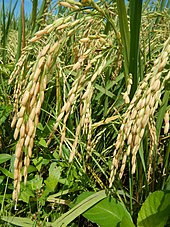
Subfamily Ehrhartoideae: rice ( Oryza sativa )

Subfamily Pooideae: Wheat ( Triticum aestivum )
PACC-clade
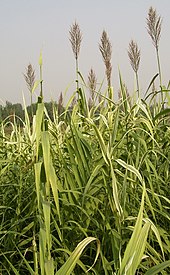
Subfamily Arundinoideae: pile tube ( Arundo donax )

Subfamily Panicoideae: Millet ( Sorghum bicolor )
|
swell
The general information in this article comes from the references listed under literature and web links (morphology, locations, distribution, etc.). In addition, individual aspects, special topics, figures, etc. are taken from the listed individual publications.
literature
- Charles Edward Hubbard: Grasses. Description, distribution, use (= UTB . Volume 233 ). 2nd, revised and expanded edition. Eugen Ulmer, Stuttgart (Hohenheim) 1985, ISBN 3-8001-2537-4 (English: Grasses . Translated by Peter Boeker).
- Peter Sitte , Elmar Weiler , Joachim W. Kadereit , Andreas Bresinsky , Christian Körner : Textbook of botany for universities . Founded by Eduard Strasburger . 35th edition. Spektrum Akademischer Verlag, Heidelberg 2002, ISBN 3-8274-1010-X .
- Ernst Klapp , Wilhelm Opitz von Boberfeld : Paperback of the grasses. Recognition and determination, location and socialization, evaluation and use . 13th revised edition. Eugen Ulmer, Stuttgart (Hohenheim) 2006, ISBN 3-8001-4775-0 .
- Wu Zheng-yi, Peter H. Raven, Deyuan Hong (Eds.): Flora of China . Volume 22: Poaceae . Science Press / Missouri Botanical Garden Press, Beijing / St. Louis 2006, ISBN 1-930723-50-4 (English).
- Vernon Hilton Heywood (Ed.): Flowering Plants of the World . Birkhäuser, Basel / Bonn / Stuttgart 1982, ISBN 3-7643-1305-6 (English: Flowering Plants of the World .).
Web links
- RJ Soreng, G. Davidse, PM Peterson, FO Zuloaga, EJ Judziewicz, TS Filgueiras, O. Morrone, K. Romaschenko: A World-wide Phylogenetic Classification of Poaceae (Gramineae). The first publication took place on January 13, 2000 as Classification of New World Grasses (Poaceae / Gramineae). The data is continuously updated, most recently on April 5, 2014.
- The Poaceae family on the AP website. (Section systematics)
- Gramineae Juss. with L. Watson and MJ Dallwitz: The Families of Flowering Plants , description in DELTA format. (Section description)
Individual evidence
- ↑ MJM Christenhusz, JW Byng: The number of known plants species in the world and its annual increase. Phytotaxa. Volume 261, No. 3, 2016, pp. 201-217. doi: 10.11646 / phytotaxa.261.3.1
- ↑ a b Vernon Hilton Heywood (ed.): Flowering plants of the world . Birkhäuser, Basel / Bonn / Stuttgart 1982, ISBN 3-7643-1305-6 (English: Flowering Plants of the World .).
- ↑ Gerhard Grümmer : The behavior of rhizomes of the couch grass (Agropyron repens) against dry air , Weed Research 3 (1), 1963, pp. 44-51.
- ^ Friedrich Kluge , Alfred Götze : Etymological dictionary of the German language . 20th edition, ed. by Walther Mitzka , De Gruyter, Berlin / New York 1967; Reprint (“21st unchanged edition”) ibid 1975, ISBN 3-11-005709-3 , p. 285.
- ↑ H. Schnyder: Physiological and morphogenetic basics of the regenerative capacity of grasses In: Bavarian Academy of Sciences (Ed.): Grasses and grassland: Biology - Use - Development , round table on October 10, 2005, Verlag Dr. Friedrich Pfeil, Munich 2006, ISBN 3-89937-070-8 , ISSN 0938-5851 .
- ↑ H. Behrendt, J. Ring: A research strategy for the investigation of the influence of environmental pollutants on the development of allergic sensitization and disease. In: J. Ring, H. Behrendt, D. Vieluf (Eds.): New Trends in Allergy IV. Springer, Berlin / Heidelberg 1997, pp. 51-60.
- ↑ a b c H. Ziegler: The family of sweet grasses. In: Bavarian Academy of Sciences (Ed.): Grasses and Grasslands: Biology - Use - Development , round table on October 10, 2005, Verlag Dr. Friedrich Pfeil, Munich, ISBN 3-89937-070-8 . ISSN 0938-5851
- ^ HL Shantz: The Place of Grasslands in the Earth's Cover. In: Ecology , Volume 35, No. 2, 1954, pp. 143-145.
- ↑ a b c d W. Haber: The grasslands of the earth: Distribution and living conditions. In: Bavarian Academy of Sciences (Ed.): Grasses and Grasslands: Biology - Use - Development , round table on October 10, 2005, Verlag Dr. Friedrich Pfeil, Munich, ISBN 3-89937-070-8 , ISSN 0938-5851 .
- ↑ a b c JH Reichholf: grasses, meat and humus. Animals in grassland ecosystems In: Bavarian Academy of Sciences (Ed.): Grasses and grasslands: Biology - Use - Development , round table on October 10, 2005, Verlag Dr. Friedrich Pfeil, Munich, ISBN 3-89937-070-8 , ISSN 0938-5851
- ^ A b H. Dierschke, G. Briemle: Kulturgrasland. Ulmer, Stuttgart 2002, ISBN 3-8001-3816-6 .
- ↑ a b c E. Bayer: Important and interesting useful plants from the grass family. In: Bavarian Academy of Sciences (Hrsg.): Grasses and grasslands: Biology - Use - Development. Round table on October 10, 2005, Verlag Dr. Friedrich Pfeil, Munich 2006, ISSN 0938-5851 , ISBN 3-89937-070-8 .
- ↑ Food and Agriculture Organization of the United Nations (FAO): Production Statistics 2018 , accessed on June 3, 2020 (English).
- ^ Vandana Prasad, Caroline AE Strömberg, Habib Alimohammadian, Ashok Sahni: Dinosaur Coprolites and the Early Evolution of Grasses and Grazers. In: Science , Volume 310 (5751), 2005, p. 1177.
- ↑ Michael Hesse: Development history and ultrastructure of pollen cement and exine in closely related entomophilic and anemophilic angiosperm clans of the Alismataceae, Liliaceae, Juncaceae, Cyperaceae, Poaceae and Araceae , Plant Systematics and Evolution, Springer Vienna 1980
- ↑ International Code of Botanical Nomenclature (PDF; 846 kB) accessed September 7, 2007
- ↑ Poaceae at Tropicos.org. Missouri Botanical Garden, St. Louis, accessed December 9, 2014.
- ↑ a b c d Poaceae in the Germplasm Resources Information Network (GRIN), USDA , ARS , National Genetic Resources Program. National Germplasm Resources Laboratory, Beltsville, Maryland. Retrieved December 9, 2014.
- ^ Grass Phylogeny Working Group, Nigel P. Barker, Lynn G. Clark, Jerrold I. Davis, Melvin R. Duvall, Gerald F. Guala, Catherine Hsiao, Elizabeth A. Kellogg, H. Peter Linder: Phylogeny and Subfamilial Classification of the Grasses (Poaceae) . Annals of the Missouri Botanical Garden, 2001, Volume 88, No. 3, 2001, pp. 373-457 ( online. )
- ↑ a b c d e f g h i j k l m n o p q r s t u v w x y z aa ab ac ad ae af ag ah ai aj ak al am Rafaël Govaerts (Ed.): Poaceae - data sheet at World Checklist of Selected Plant Families of the Board of Trustees of the Royal Botanic Gardens, Kew . Retrieved December 9, 2014
- ↑ RJ Soreng, G. Davidse, PM Peterson, FO Zuloaga, EJ Judziewicz, TS Filgueiras, O. Morrone, K. Romaschenko: A World-wide Phylogenetic Classification of Poaceae (Gramineae). The first publication took place on January 13, 2000 as Classification of New World Grasses (Poaceae / Gramineae). The data is continuously updated, most recently on April 5, 2014.

